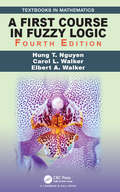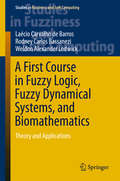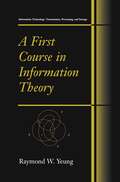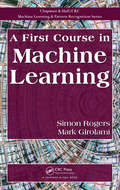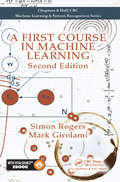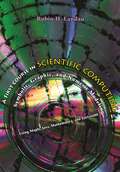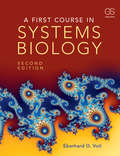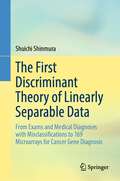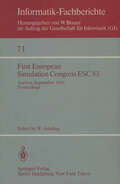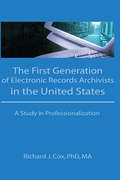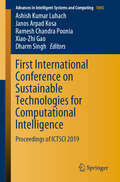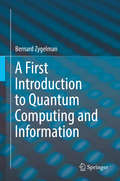- Table View
- List View
A First Course in Fuzzy Logic (Textbooks in Mathematics)
by Hung T. Nguyen Elbert A. Walker Carol L. WalkerA First Course in Fuzzy Logic, Fourth Edition is an expanded version of the successful third edition. It provides a comprehensive introduction to the theory and applications of fuzzy logic. This popular text offers a firm mathematical basis for the calculus of fuzzy concepts necessary for designing intelligent systems and a solid background for readers to pursue further studies and real-world applications. New in the Fourth Edition: Features new results on fuzzy sets of type-2 Provides more information on copulas for modeling dependence structures Includes quantum probability for uncertainty modeling in social sciences, especially in economics With its comprehensive updates, this new edition presents all the background necessary for students, instructors and professionals to begin using fuzzy logic in its many—applications in computer science, mathematics, statistics, and engineering. About the Authors: Hung T. Nguyen is a Professor Emeritus at the Department of Mathematical Sciences, New Mexico State University. He is also an Adjunct Professor of Economics at Chiang Mai University, Thailand. Carol L. Walker is also a Professor Emeritus at the Department of Mathematical Sciences, New Mexico State University. Elbert A. Walker is a Professor Emeritus, Department of Mathematical Sciences, New Mexico State University.
A First Course in Fuzzy Logic, Fuzzy Dynamical Systems, and Biomathematics: Theory and Applications (Studies in Fuzziness and Soft Computing #347)
by Laécio Carvalho de Barros Rodney Carlos Bassanezi Weldon Alexander LodwickThis book provides an essential introduction to the field of dynamical models. Starting from classical theories such as set theory and probability, it allows readers to draw near to the fuzzy case. On one hand, the book equips readers with a fundamental understanding of the theoretical underpinnings of fuzzy sets and fuzzy dynamical systems. On the other, it demonstrates how these theories are used to solve modeling problems in biomathematics, and presents existing derivatives and integrals applied to the context of fuzzy functions. Each of the major topics is accompanied by examples, worked-out exercises, and exercises to be completed. Moreover, many applications to real problems are presented. The book has been developed on the basis of the authors’ lectures to university students and is accordingly primarily intended as a textbook for both upper-level undergraduates and graduates in applied mathematics, statistics, and engineering. It also offers a valuable resource for practitioners such as mathematical consultants and modelers, and for researchers alike, as it may provide both groups with new ideas and inspirations for projects in the fields of fuzzy logic and biomathematics.
A First Course in Information Theory (Information Technology: Transmission, Processing and Storage)
by Raymond W. YeungThis book provides an up-to-date introduction to information theory. In addition to the classical topics discussed, it provides the first comprehensive treatment of the theory of I-Measure, network coding theory, Shannon and non-Shannon type information inequalities, and a relation between entropy and group theory. ITIP, a software package for proving information inequalities, is also included. With a large number of examples, illustrations, and original problems, this book is excellent as a textbook or reference book for a senior or graduate level course on the subject, as well as a reference for researchers in related fields.
A First Course in Machine Learning
by Mark GirolamiA First Course in Machine Learning covers the core mathematical and statistical techniques needed to understand some of the most popular machine learning algorithms. The algorithms presented span the main problem areas within machine learning: classification, clustering and projection. The text gives detailed descriptions and derivations for a smal
A First Course in Machine Learning
by Simon Rogers Mark Girolami"A First Course in Machine Learning by Simon Rogers and Mark Girolami is the best introductory book for ML currently available. It combines rigor and precision with accessibility, starts from a detailed explanation of the basic foundations of Bayesian analysis in the simplest of settings, and goes all the way to the frontiers of the subject such as infinite mixture models, GPs, and MCMC."—Devdatt Dubhashi, Professor, Department of Computer Science and Engineering, Chalmers University, Sweden "This textbook manages to be easier to read than other comparable books in the subject while retaining all the rigorous treatment needed. The new chapters put it at the forefront of the field by covering topics that have become mainstream in machine learning over the last decade."—Daniel Barbara, George Mason University, Fairfax, Virginia, USA "The new edition of A First Course in Machine Learning by Rogers and Girolami is an excellent introduction to the use of statistical methods in machine learning. The book introduces concepts such as mathematical modeling, inference, and prediction, providing ‘just in time’ the essential background on linear algebra, calculus, and probability theory that the reader needs to understand these concepts."—Daniel Ortiz-Arroyo, Associate Professor, Aalborg University Esbjerg, Denmark "I was impressed by how closely the material aligns with the needs of an introductory course on machine learning, which is its greatest strength…Overall, this is a pragmatic and helpful book, which is well-aligned to the needs of an introductory course and one that I will be looking at for my own students in coming months."—David Clifton, University of Oxford, UK "The first edition of this book was already an excellent introductory text on machine learning for an advanced undergraduate or taught masters level course, or indeed for anybody who wants to learn about an interesting and important field of computer science. The additional chapters of advanced material on Gaussian process, MCMC and mixture modeling provide an ideal basis for practical projects, without disturbing the very clear and readable exposition of the basics contained in the first part of the book." —Gavin Cawley, Senior Lecturer, School of Computing Sciences, University of East Anglia, UK "This book could be used for junior/senior undergraduate students or first-year graduate students, as well as individuals who want to explore the field of machine learning…The book introduces not only the concepts but the underlying ideas on algorithm implementation from a critical thinking perspective."—Guangzhi Qu, Oakland University, Rochester, Michigan, USA
A First Course in Machine Learning
by Simon Rogers Mark Girolami"A First Course in Machine Learning by Simon Rogers and Mark Girolami is the best introductory book for ML currently available. It combines rigor and precision with accessibility, starts from a detailed explanation of the basic foundations of Bayesian analysis in the simplest of settings, and goes all the way to the frontiers of the subject such as infinite mixture models, GPs, and MCMC."—Devdatt Dubhashi, Professor, Department of Computer Science and Engineering, Chalmers University, Sweden "This textbook manages to be easier to read than other comparable books in the subject while retaining all the rigorous treatment needed. The new chapters put it at the forefront of the field by covering topics that have become mainstream in machine learning over the last decade."—Daniel Barbara, George Mason University, Fairfax, Virginia, USA "The new edition of A First Course in Machine Learning by Rogers and Girolami is an excellent introduction to the use of statistical methods in machine learning. The book introduces concepts such as mathematical modeling, inference, and prediction, providing ‘just in time’ the essential background on linear algebra, calculus, and probability theory that the reader needs to understand these concepts."—Daniel Ortiz-Arroyo, Associate Professor, Aalborg University Esbjerg, Denmark "I was impressed by how closely the material aligns with the needs of an introductory course on machine learning, which is its greatest strength…Overall, this is a pragmatic and helpful book, which is well-aligned to the needs of an introductory course and one that I will be looking at for my own students in coming months."—David Clifton, University of Oxford, UK "The first edition of this book was already an excellent introductory text on machine learning for an advanced undergraduate or taught masters level course, or indeed for anybody who wants to learn about an interesting and important field of computer science. The additional chapters of advanced material on Gaussian process, MCMC and mixture modeling provide an ideal basis for practical projects, without disturbing the very clear and readable exposition of the basics contained in the first part of the book." —Gavin Cawley, Senior Lecturer, School of Computing Sciences, University of East Anglia, UK "This book could be used for junior/senior undergraduate students or first-year graduate students, as well as individuals who want to explore the field of machine learning…The book introduces not only the concepts but the underlying ideas on algorithm implementation from a critical thinking perspective."—Guangzhi Qu, Oakland University, Rochester, Michigan, USA
A First Course in Scientific Computing: Symbolic, Graphic, and Numeric Modeling Using Maple, Java, Mathematica, and Fortran90
by Rubin H. LandauThis book offers a new approach to introductory scientific computing. It aims to make students comfortable using computers to do science, to provide them with the computational tools and knowledge they need throughout their college careers and into their professional careers, and to show how all the pieces can work together. Rubin Landau introduces the requisite mathematics and computer science in the course of realistic problems, from energy use to the building of skyscrapers to projectile motion with drag. He is attentive to how each discipline uses its own language to describe the same concepts and how computations are concrete instances of the abstract. Landau covers the basics of computation, numerical analysis, and programming from a computational science perspective. The first part of the printed book uses the problem-solving environment Maple as its context, with the same material covered on the accompanying CD as both Maple and Mathematica programs; the second part uses the compiled language Java, with equivalent materials in Fortran90 on the CD; and the final part presents an introduction to LaTeX replete with sample files. Providing the essentials of computing, with practical examples, A First Course in Scientific Computing adheres to the principle that science and engineering students learn computation best while sitting in front of a computer, book in hand, in trial-and-error mode. Not only is it an invaluable learning text and an essential reference for students of mathematics, engineering, physics, and other sciences, but it is also a consummate model for future textbooks in computational science and engineering courses. A broad spectrum of computing tools and examples that can be used throughout an academic career Practical computing aimed at solving realistic problems Both symbolic and numerical computations A multidisciplinary approach: science + math + computer science Maple and Java in the book itself; Mathematica, Fortran90, Maple and Java on the accompanying CD in an interactive workbook format
A First Course in Scientific Computing: Symbolic, Graphic, and Numeric Modeling Using Maple, Java, Mathematica, and Fortran90 (PDF)
by Rubin H. LandauThis book offers a new approach to introductory scientific computing. It aims to make students comfortable using computers to do science, to provide them with the computational tools and knowledge they need throughout their college careers and into their professional careers, and to show how all the pieces can work together. Rubin Landau introduces the requisite mathematics and computer science in the course of realistic problems, from energy use to the building of skyscrapers to projectile motion with drag. He is attentive to how each discipline uses its own language to describe the same concepts and how computations are concrete instances of the abstract. Landau covers the basics of computation, numerical analysis, and programming from a computational science perspective. The first part of the printed book uses the problem-solving environment Maple as its context, with the same material covered on the accompanying CD as both Maple and Mathematica programs; the second part uses the compiled language Java, with equivalent materials in Fortran90 on the CD; and the final part presents an introduction to LaTeX replete with sample files. Providing the essentials of computing, with practical examples, A First Course in Scientific Computing adheres to the principle that science and engineering students learn computation best while sitting in front of a computer, book in hand, in trial-and-error mode. Not only is it an invaluable learning text and an essential reference for students of mathematics, engineering, physics, and other sciences, but it is also a consummate model for future textbooks in computational science and engineering courses. A broad spectrum of computing tools and examples that can be used throughout an academic career Practical computing aimed at solving realistic problems Both symbolic and numerical computations A multidisciplinary approach: science + math + computer science Maple and Java in the book itself; Mathematica, Fortran90, Maple and Java on the accompanying CD in an interactive workbook format
A First Course in Statistical Inference (Springer Undergraduate Mathematics Series)
by Jonathan GillardThis book offers a modern and accessible introduction to Statistical Inference, the science of inferring key information from data. Aimed at beginning undergraduate students in mathematics, it presents the concepts underpinning frequentist statistical theory.Written in a conversational and informal style, this concise text concentrates on ideas and concepts, with key theorems stated and proved. Detailed worked examples are included and each chapter ends with a set of exercises, with full solutions given at the back of the book. Examples using R are provided throughout the book, with a brief guide to the software included. Topics covered in the book include: sampling distributions, properties of estimators, confidence intervals, hypothesis testing, ANOVA, and fitting a straight line to paired data.Based on the author’s extensive teaching experience, the material of the book has been honed by student feedback for over a decade. Assuming only some familiarity with elementary probability, this textbook has been devised for a one semester first course in statistics.
A First Course in Systems Biology
by Eberhard VoitA First Course in Systems Biology is an introduction for advanced undergraduate and graduate students to the growing field of systems biology. Its main focus is the development of computational models and their applications to diverse biological systems. The book begins with the fundamentals of modeling, then reviews features of the molecular inventories that bring biological systems to life and discusses case studies that represent some of the frontiers in systems biology and synthetic biology. In this way, it provides the reader with a comprehensive background and access to methods for executing standard systems biology tasks, understanding the modern literature, and launching into specialized courses or projects that address biological questions using theoretical and computational means. New topics in this edition include: default modules for model design, limit cycles and chaos, parameter estimation in Excel, model representations of gene regulation through transcription factors, derivation of the Michaelis-Menten rate law from the original conceptual model, different types of inhibition, hysteresis, a model of differentiation, system adaptation to persistent signals, nonlinear nullclines, PBPK models, and elementary modes. The format is a combination of instructional text and references to primary literature, complemented by sets of small-scale exercises that enable hands-on experience, and large-scale, often open-ended questions for further reflection.
A First Course in Systems Biology
by Eberhard VoitA First Course in Systems Biology is an introduction for advanced undergraduate and graduate students to the growing field of systems biology. Its main focus is the development of computational models and their applications to diverse biological systems. The book begins with the fundamentals of modeling, then reviews features of the molecular inventories that bring biological systems to life and discusses case studies that represent some of the frontiers in systems biology and synthetic biology. In this way, it provides the reader with a comprehensive background and access to methods for executing standard systems biology tasks, understanding the modern literature, and launching into specialized courses or projects that address biological questions using theoretical and computational means. New topics in this edition include: default modules for model design, limit cycles and chaos, parameter estimation in Excel, model representations of gene regulation through transcription factors, derivation of the Michaelis-Menten rate law from the original conceptual model, different types of inhibition, hysteresis, a model of differentiation, system adaptation to persistent signals, nonlinear nullclines, PBPK models, and elementary modes. The format is a combination of instructional text and references to primary literature, complemented by sets of small-scale exercises that enable hands-on experience, and large-scale, often open-ended questions for further reflection.
First Course on Fuzzy Theory and Applications (Advances in Intelligent and Soft Computing #27)
by Kwang Hyung LeeFuzzy theory has become a subject that generates much interest among the courses for graduate students. However, it was not easy to find a suitable textbook to use in the introductory course and to recommend to the students who want to self-study. The main purpose of this book is just to meet that need. The author has given lectures on the fuzzy theory and its applications for ten years and continuously developed lecture notes on the subject. This book is a publication of the modification and summary of the lecture notes. The fundamental idea of the book is to provide basic and concrete concepts of the fuzzy theory and its applications, and thus the author focused on easy illustrations of the basic concepts. There are numerous examples and figures to help readers to understand and also added exercises at the end of each chapter. This book consists of two parts: a theory part and an application part. The first part (theory part) includes chapters from 1 to 8. Chapters 1 and 2 introduce basic concepts of fuzzy sets and operations, and Chapters 3 and 4 deal with the multi-dimensional fuzzy sets. Chapters 5 and 6 are extensions of the fuzzy theory to the number and function, and Chapters 7 and 8 are developments of fuzzy properties on the probability and logic theories.
The First Discriminant Theory of Linearly Separable Data: From Exams and Medical Diagnoses with Misclassifications to 169 Microarrays for Cancer Gene Diagnosis
by Shuichi ShinmuraThis book deals with the first discriminant theory of linearly separable data (LSD), Theory3, based on the four ordinary LSD of Theory1 and 169 microarrays (LSD) of Theory2. Furthermore, you can quickly analyze the medical data with the misclassified patients which is the true purpose of diagnoses. Author developed RIP (Optimal-linear discriminant function finding the combinatorial optimal solution) as Theory1 in decades ago, that found the minimum misclassifications. RIP discriminated 63 (=26−1) models of Swiss banknote (200*6) and found the minimum LSD: basic gene set (BGS). In Theory2, RIP discriminated Shipp microarray (77*7129) which was LSD and had only 32 nonzero coefficients (first Small Matryoshka; SM1). Because RIP discriminated another 7,097 genes and found SM2, the author developed the Matryoshka feature selection Method 2 (Program 3), that splits microarray into many SMs. Program4 can split microarray into many BGSs. Then, the wide columnLSD (Revolution-0), such as microarray (n Theory3 shows the surprising results of six ordinary data re-analyzed by Theory1 and Theory2 knowledge. Essence of Theory3 is described by using cephalopelvic disproportion (CPD) data. RIP discriminates CPD data (240*19) and finds two misclassifications unique for cesarean and natural-born groups. CPD238 omitting two patients becomes LSD, which is the first case selection method. Program4 finds BGS (14 vars.) the only variable selection method for Theory3. 32 (=25) models, including BGS, become LSD among (219−1) models. Because Program2 confirms BGS has the minimum average error rate, BGS is the most compact and best model satisfying Occam’s Razor. With this book, physicians obtain complete diagnostic results for disease, and engineers can become a true data scientist, by obtaining integral knowledge ofstatistics and mathematical programming with simple programs.
First European Simulation Congress ESC 83: Aachen, September, 12–16, 1983 Proceedings (Informatik-Fachberichte #71)
by W. AmelingWelcome to Aachen and to the First European Simulation Congress ESC83, a triennial international conference jointly promoted by ASIM/GI, DBSS, SIMS and UKSC. ESC83 is organized by ASIM/GI,. supported by SCS and IMACS, and sponsored by NGI (section for simulation). It takes place at the Karman Auditorium of the Aachen Technical Univer sity, FRG. The aim of ESC83 is to cover all aspects of modeling and simulation in theory and practice, to promote the exchange of knowlewdge and experience between different international research groups in this field, and to strengthen the international contact between developers and users of modeling and simulation techniques. On the occasion of the Congress people of scientific and engineering disciplines will meet to discuss the state of the art and future activities and developments. A large number of contributed papers has been strictly examined and selected by the Scientific Committee to guarantee a high international standard. The book contains the accepted papers that will be presented at the Congress. The papers have been classified according to the following keywords.
The First Generation of Electronic Records Archivists in the United States: A Study in Professionalization
by Richard CoxThis book helps readers understand the current status of archivists in the United States. It addresses issues of professionalization by re-examining two major aspects of the archival community: institutional forms and structures, and the basic educational foundations that are important to any profession. While United States archivists now seem poised to develop new approaches to the management of electronic records, including research and education venues, this profession?s long journey to reach this point is an interesting step on the continuing road to professionalization. The First Generation of Electronic Records Archivists in the United States represents the first major study of how and why American archivists have struggled to contend with the management of electronic records. The book provides a framework for studying this issue, includes suggestions for additional research, and serves as a basis for discussion about the continued strengthening of the archival profession. Despite more than thirty years of striving to manage electronic records, American archivists have not developed an effective infrastructure for this purpose. The First Generation of Electronic Records Archivists in the United States considers the evidence for this failure by evaluating archival literature on the topic of electronic records management. It examines how position descriptions in state government archives and job advertisements across the discipline have reflected a bias toward paper-based formats, and the failure of graduate and continuing archival education programs to deal effectively with electronic records. The book details:state government archives and position descriptionstrends and practices in the Information Age, 1976--1990graduate archival education and electronic records: an analysis of current approaches and their strengths and weaknessesthe effectiveness of the NAGARA Institute as a form of advanced archival educationproblems, challenges, opportunities, and needs for additional researchThe First Generation of Electronic Records Archivists in the United States is an enlightening study for library and information science educators, archival graduate students, and archivists themselves as they work toward the professionalization of their field.
The First Generation of Electronic Records Archivists in the United States: A Study in Professionalization
by Richard CoxThis book helps readers understand the current status of archivists in the United States. It addresses issues of professionalization by re-examining two major aspects of the archival community: institutional forms and structures, and the basic educational foundations that are important to any profession. While United States archivists now seem poised to develop new approaches to the management of electronic records, including research and education venues, this profession?s long journey to reach this point is an interesting step on the continuing road to professionalization. The First Generation of Electronic Records Archivists in the United States represents the first major study of how and why American archivists have struggled to contend with the management of electronic records. The book provides a framework for studying this issue, includes suggestions for additional research, and serves as a basis for discussion about the continued strengthening of the archival profession. Despite more than thirty years of striving to manage electronic records, American archivists have not developed an effective infrastructure for this purpose. The First Generation of Electronic Records Archivists in the United States considers the evidence for this failure by evaluating archival literature on the topic of electronic records management. It examines how position descriptions in state government archives and job advertisements across the discipline have reflected a bias toward paper-based formats, and the failure of graduate and continuing archival education programs to deal effectively with electronic records. The book details:state government archives and position descriptionstrends and practices in the Information Age, 1976--1990graduate archival education and electronic records: an analysis of current approaches and their strengths and weaknessesthe effectiveness of the NAGARA Institute as a form of advanced archival educationproblems, challenges, opportunities, and needs for additional researchThe First Generation of Electronic Records Archivists in the United States is an enlightening study for library and information science educators, archival graduate students, and archivists themselves as they work toward the professionalization of their field.
First International Conference on Artificial Intelligence and Cognitive Computing: Aicc 2018 (Advances In Intelligent Systems and Computing #815)
by Raju Surampudi Bapi Koppula Srinivas Rao Munaga V. PrasadThis book presents original research works by researchers, engineers and practitioners in the field of artificial intelligence and cognitive computing. The book is divided into two parts, the first of which focuses on artificial intelligence (AI), knowledge representation, planning, learning, scheduling, perception-reactive AI systems, evolutionary computing and other topics related to intelligent systems and computational intelligence. In turn, the second part focuses on cognitive computing, cognitive science and cognitive informatics. It also discusses applications of cognitive computing in medical informatics, structural health monitoring, computational intelligence, intelligent control systems, bio-informatics, smart manufacturing, smart grids, image/video processing, video analytics, medical image and signal processing, and knowledge engineering, as well as related applications.
First International Conference on Sustainable Technologies for Computational Intelligence: Proceedings of ICTSCI 2019 (Advances in Intelligent Systems and Computing #1045)
by Xiao-Zhi Gao Dharm Singh Ashish Kumar Luhach Janos Arpad Kosa Ramesh Chandra PooniaThis book gathers high-quality papers presented at the First International Conference on Sustainable Technologies for Computational Intelligence (ICTSCI 2019), which was organized by Sri Balaji College of Engineering and Technology, Jaipur, Rajasthan, India, on March 29–30, 2019. It covers emerging topics in computational intelligence and effective strategies for its implementation in engineering applications.
First International Workshop on Larch: Proceedings of the First International Workshop on Larch, Dedham, Massachusetts, USA, 13–15 July 1992 (Workshops in Computing)
by Ursula Martin Jeannette M. WingThe papers in this volume were presented at the First International Workshop on Larch, held at MIT Endicott House near Boston on 13-15 July 1992. Larch is a family of formal specification languages and tools, and this workshop was a forum for those who have designed the Larch languages, built tool support for them, particularly the Larch Prover, and used them to specify and reason about software and hardware systems. The Larch Project started in 1980, led by John Guttag at MIT and James Horning, then at Xerox/Palo Alto Research Center and now at Digital Equipment Corporation/Systems Research Center (DEC/SRC). Major applications have included VLSI circuit synthesis, medical device communications, compiler development and concurrent systems based on Lamport's TLA, as well as several applications to classical theorem proving and algebraic specification. Larch supports a two-tiered approach to specifying software and hardware modules. One tier of a specification is wrillen in the Larch Shared Language (LSL). An LSL specification describes mathematical abstractions such as sets, relations, and algebras; its semantics is defined in terms of first-order theories. The second tier is written in a Larch interface language, one designed for a specific programming language. An interface specification describes the effects of individual modules, e.g. state changes, resource allocation, and exceptions; its semantics is defined in terms of first-order predicates over two states, where state is defined in terms of the programming language's notion of state. Thus, LSL is programming language independent; a Larch interface language is programming language dependent.
A First Introduction to Quantum Computing and Information
by Bernard ZygelmanThis book addresses and introduces new developments in the field of Quantum Information and Computing (QIC) for a primary audience of undergraduate students. Developments over the past few decades have spurred the need for QIC courseware at major research institutions. This book broadens the exposure of QIC science to the undergraduate market. The subject matter is introduced in such a way so that it is accessible to students with only a first-year calculus background. Greater accessibility allows a broader range of academic offerings. Courses, based on this book, could be offered in the Physics, Engineering, Math and Computer Science departments. This textbook incorporates Mathematica-based examples into the book. In this way students are allowed a hands-on experience in which difficult abstract concepts are actualized by simulations. The students can ‘turn knobs" in parameter space and explore how the system under study responds. The incorporation of symbolic manipulation software into course-ware allows a more holistic approach to the teaching of difficult concepts. Mathematica software is used here because it is easy to use and allows a fast learning curve for students who have limited experience with scientific programming.
A First Introduction to the Finite Element Analysis Program MSC Marc/Mentat
by Andreas Öchsner Marco ÖchsnerThis book offers a brief introduction to the general-purpose finite element program MSC Marc, focusing on providing simple examples, often single-element problems, which can easily be related to the theory that is discussed in finite element lectures. As such, it is an ideal companion book to classical introductory courses on the finite element method. MSC Marc is a specialized program for non-linear problems (implicit solver), which is distributed by the MSC Software Corporation and commonly used in academia and industry. The documentation of all finite element programs now includes a variety of step-by-step examples of differing complexity, and all software companies offer professional workshops on different topics. Since the first edition of the book, there have been several new releases of Marc/Mentat and numerous changes. This new edition incorporates the latest Marc/Mentat software developments and new examples.
First Leaves: A Tutorial Introduction to Maple V
by Bruce W. Char Keith O. Geddes Gaston H. Gonnet Benton L. Leong Michael B. Monagan Stephen M. WattThis tutorial shows how to use Maple both as a calculator with instant access to hundreds of high-level math routines and as a programming language for more demanding tasks. It covers topics such as the basic data types and statements in the Maple language. It explains the differences between numeric computation and symbolic computation and illustrates how both are used in Maple. Extensive "how-to" examples are used throughout the tutorial to show how common types of calculations can be expressed easily in Maple. The manual also uses many graphics examples to illustrate the way in which 2D and 3D graphics can aid in understanding the behavior of functions.
The First Line of Code: Android Programming with Kotlin
by Lin GuoThe First Line of Code is a must-have for developers who want to learn Android and Kotlin, and the best-seller in China. Knowledge between Android and Kotlin is interspersed in a way that readers are easy to understand and get start:· Android part covers all the important aspects of the Android platform, such as activity, service, content provider, broadcast receiver, fragment, basic UI, data storage, network, Jetpack and other application-level knowledge. · Kotlin part covers various aspects of Kotlin, such as standard grammar, common skills, higher-order functions, generics, coroutines, DSL and other language-level knowledge. In addition, The First Line of Code is a very practicing book, illustrating concepts with a complete weather forecast program. You can use and practice all the knowledge comprehensively after learning and see the actual result for what you have learned through the book. All contents of the book are quite easy to understand. It might be a good choice for both beginners and experienced developers. Also suitable for college students, college teachers, etc.
First-order and Stochastic Optimization Methods for Machine Learning (Springer Series in the Data Sciences)
by Guanghui LanThis book covers not only foundational materials but also the most recent progresses made during the past few years on the area of machine learning algorithms. In spite of the intensive research and development in this area, there does not exist a systematic treatment to introduce the fundamental concepts and recent progresses on machine learning algorithms, especially on those based on stochastic optimization methods, randomized algorithms, nonconvex optimization, distributed and online learning, and projection free methods. This book will benefit the broad audience in the area of machine learning, artificial intelligence and mathematical programming community by presenting these recent developments in a tutorial style, starting from the basic building blocks to the most carefully designed and complicated algorithms for machine learning.
First-Order Logic and Automated Theorem Proving (Texts in Computer Science)
by Melvin FittingThere are many kinds of books on formal logic. Some have philosophers as their intended audience, some mathematicians, some computer scien tists. Although there is a common core to all such books, they will be very different in emphasis, methods, and even appearance. This book is intended for computer scientists. But even this is not precise. Within computer science formal logic turns up in a number of areas, from pro gram verification to logic programming to artificial intelligence. This book is intended for computer scientists interested in automated theo rem proving in classical logic. To be more precise yet, it is essentially a theoretical treatment, not a how-to book, although how-to issues are not neglected. This does not mean, of course, that the book will be of no interest to philosophers or mathematicians. It does contain a thorough presentation of formal logic and many proof techniques, and as such it contains all the material one would expect to find in a course in formal logic covering completeness but, not incompleteness issues. The first item to be addressed is, What are we talking about and why are we interested in it? We are primarily talking about truth as used in mathematical discourse, and our interest in it is, or should be, self evident. Truth is a semantic concept, so we begin with models and their properties. These are used to define our subject.
